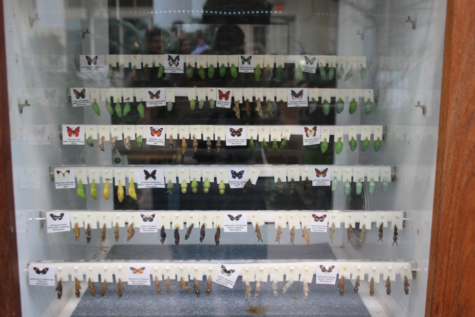Springtime crawls into Hershey Gardens with interactive bug activities
May 15, 2018

After 16 years of outdoor operation, moving indoors seemed like a big step, but it ended up with the best environmental outcome.
With one of the only 25 indoor butterfly atriums in the country, the Hershey Gardens’ Butterfly Atrium is home to dozens of rare butterflies from South and Central America, Africa and Asia. Along with the atrium, the Hershey Gardens offers additional other interactive bug activities and educational opportunities.
Brooke Umberger, the manager of the conservatory habitats at the Hershey Gardens, said “having the conservatory indoors really allows us to take the educational aspect much further than we could with the outdoor conservatory.”
The Butterfly Atrium is open year round and can house up to 600 species of butterflies. The atrium allows for visitors to view many different kinds of moths and butterflies from several parts of the world, as well as some native species.
Visitors to the atrium should be prepared for some warm temperatures, as the atrium is heated to provide optimal conditions for the butterflies and moths. Optimal temperatures, and humidity fall between 75-80 degrees, and 80-85% humidity.
Umberger said, “the USDA (United States Department of Agriculture) doesn’t allow us to raise any of the host plants that would allow for butterfly or moth reproduction.” The plants that cover the atrium are all known as nectar plants, which are just food sources for the moths and butterflies.
Most of the butterflies inside the atrium are classified as specialists. In this case, a specialist is a type of butterfly or moth that will only lay its eggs on a specific kind of plant. Insects that don’t need a special plant are kept within insect friendly netting.
The Bug Zone, which is located inside the Butterfly Atrium, is a small area where a cluster of miniature enclosures with four different kinds of non native insects. People inside the artium can view the insects while walking throughout the conservatory.
The insects from the Bug Zone included the Jungle Nymph, commonly found in Southeast Asia. Along with the Blue Feigning Death Beetle, which is commonly found in the desert regions of the Southwestern areas of the United States.
The two other species of insects located in the Zone included the Orchid Mantis, commonly found in the forests of Southeast Asia, and the Eastern Lubber Grasshopper, which is commonly found in the United States.
Staff member Marc Baase, who works in the atrium and at the cart, said “This is really what is best for them, being inside in a controlled area.” Since the atrium isn’t housed outdoors, the Hershey Gardens can keep the atrium open year round, and provide the best living environment for the insects.
The interactive “Touch-a-Bug” cart, which can be run by volunteers or by staff members, is an open experience where people can come and learn about the displayed species of insects and arachnids that the Gardens has available for its educational programs.
The cart allows for visitors to learn and view a few species of interesting insects and a species of arachnid. Children could ask the staff member running the cart if they could hold the pupa of the caterpillars, or touch the Madagascar Hissing Cockroach that was crawling along the staff members arm.
Caroleanne Snitger, a staff member at the Gardens, said, “most of us actively avoid having to hold the tarantula.”
Taylor Koda, a freshman from Hershey High School and a volunteer at the Gardens, said “volunteering was really all about the experience. It was really cool being so submerged in the environment around me.”
For some, the excitement of being surrounded by so many separate parts of an ecosystem is uncontainable. Such is the case of Shane Ulrich, a 9 year old visitor to the Gardens who was watching butterflies inside the atrium.
Ulrich said, “There’s one here, and over there, and on the wall and. Oh, they’re on the ceiling. They’re everywhere.”






